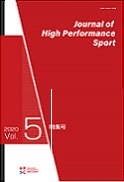5 巻
選択された号の論文の14件中1~14を表示しています
- |<
- <
- 1
- >
- >|
特集 国立スポーツ科学センターにおけるパラリンピックアスリートへの医・科学支援および研究の取り組み
-
2020 年 5 巻 p. 1-3
発行日: 2020年
公開日: 2020/04/26
PDF形式でダウンロード (351K) -
2020 年 5 巻 p. 4-11
発行日: 2020年
公開日: 2020/04/26
PDF形式でダウンロード (1330K) -
2020 年 5 巻 p. 12-22
発行日: 2020年
公開日: 2020/04/26
PDF形式でダウンロード (1672K) -
2020 年 5 巻 p. 23-28
発行日: 2020年
公開日: 2020/04/26
PDF形式でダウンロード (1168K) -
2020 年 5 巻 p. 29-34
発行日: 2020年
公開日: 2020/04/26
PDF形式でダウンロード (869K) -
2020 年 5 巻 p. 35-43
発行日: 2020年
公開日: 2020/04/26
PDF形式でダウンロード (592K) -
2020 年 5 巻 p. 44-52
発行日: 2020年
公開日: 2020/04/26
PDF形式でダウンロード (618K)
特集 国際オリンピック委員会のサプリメント合意声明の紹介
-
2020 年 5 巻 p. 53-57
発行日: 2020年
公開日: 2020/10/04
PDF形式でダウンロード (437K) -
2020 年 5 巻 p. 58-64
発行日: 2020年
公開日: 2020/10/04
PDF形式でダウンロード (288K) -
2020 年 5 巻 p. 65-79
発行日: 2020年
公開日: 2020/10/04
PDF形式でダウンロード (1055K) -
2020 年 5 巻 p. 80-85
発行日: 2020年
公開日: 2020/10/04
PDF形式でダウンロード (872K) -
2020 年 5 巻 p. 86-92
発行日: 2020年
公開日: 2020/10/04
PDF形式でダウンロード (396K) -
2020 年 5 巻 p. 93-105
発行日: 2020年
公開日: 2020/10/04
PDF形式でダウンロード (771K) -
2020 年 5 巻 p. 106-113
発行日: 2020年
公開日: 2020/10/04
PDF形式でダウンロード (2421K)
- |<
- <
- 1
- >
- >|
